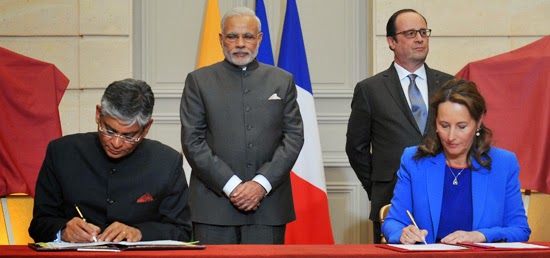 |
| Prime Minister Narendra Modi paying homage to Sri Aurobindo at UNESCO |
I write ‘purchase’ because the deal is not signed as yet.
There is nothing about the multi-role combat aircraft in the 20-point ‘List of agreements/initiatives/announcements signed/agreed during visit of Indian Prime Minister to France’, published by the Ministry of External Affairs.
Only the Joint Statement issued at the end of the meeting between the French President and Indian Prime Minister mentioned the Rafales.
Point 14 says: “Government of India conveyed to the Government of France that in view of the critical operational necessity for Multirole Combat Aircraft for Indian Air Force, Government of India would like to acquire [36] Rafale jets in fly-away condition as quickly as possible. The two leaders agreed to conclude an Inter-Governmental Agreement for supply of the aircraft on terms that would be better than conveyed by Dassault Aviation as part of a separate process underway; the delivery would be in time-frame that would be compatible with the operational requirement of IAF; and that the aircraft and associated systems and weapons would be delivered on the same configuration as had been tested and approved by Indian Air Force, and with a longer maintenance responsibility by France.”
In other words, a contract still needs to be negotiated ...and signed.
Let us not forget that in December 1981, the purchase of 150 Mirages 2000 was announced to counter the American F 16 ordered by Pakistan, but the final agreement was for 40 planes only, although a preferential credit rate of 9,25 % was then offered to India.
At that time too, the Indian Air Force needed the fighter aircraft quickly; it was therefore decided to ship an initial batch of 26 single-seaters and 4 two-seaters in 1985. The second part of this initial batch consisted of 10 more single-seater with the M53-P2 engine, with these aircraft designated Mirage 2000H.
A second consignment of six Mirage 2000H single-seater and three Mirage 2000TH two-seater was shipped in 1987-1988. Nine more planes were ordered in 1986. At that time, as a ‘bonus’, Indian engineers received a six-month training in France with Dassault and Dassault-Systems.
Further in 1984, a core group started the Aeronautical Development Agency (ADA) in Bangalore. The ADA was to oversee the development of India's Light Combat Aircraft (LCA) program. For a short time, French engineers worked on the Tejas program.
The tragedy is that India has lost 14 years to reach yesterday’s decision.
Can you imagine that the initial Request for Information had been issued in 2001, 14 years ago!
It is only 6 years later that the Request for Proposal (RFP) was published, as the then minister, AK Antony wanted to add new clauses, such as the Total Life-cycle Costs, in the Indian defence procurement policy. This is where the ‘complications’ started.
Five years later, in January 2012, Dassault Aviation was selected for supplying 126 Medium Multi-Role Combat Aircrafts (MMRCA) to the IAF after a long competitive process which lasted five years, with the American F/A-18 and F-16, Russian MiG 35, European Eurofighter and Swedish Saab Gripen in the race.
Why so many years from nothing?
The answer is mainly because of the complicated and tortuous Defence Procurement Policy drafted by the former ‘honest’ Defence Minister.
If one believes yesterday’s Joint Statement, an Inter-Governmental Agreement will now be signed, putting the last nail into the MMRCA deal.
As soon as a new Defense Procurement Policy is published, negotiations for a transfer of technology to HAL or any other Indian firm involved in defense production, can start.
It may take some time.
It is worth noting that the Indian Prime Minister gave priority to the requirement of the Indian defense forces versus his pet project 'Make in India', which will be delayed for a few years, as far as the Rafale transfer of technology is concerned.
 |
| With Madam Bokova |
Another highlight of Modi’s first day in Paris (he arrived late in the evening of the previous day) was the visit to UNESCO and his speech on Indian and Universal values.
Before reaching the main auditorium, he was received by Madam Irena Bokova (read my interview with the UNESCO's Director General) in front of Sri Aurobindo statue outside the building.
The Indian Prime Minister paid floral tribute to the Indian rishi.
Always well-informed, an Indian agency said that he paid tribute to Rabindranath Tagore.
It is true that the great Poet had a great admiration for the integral yogi. After visiting Pondicherry in 1928, Tagore wrote: ‘Rabindranath, O Aurobindo, bows to thee! O friend, my country's friend, O Voice incarnate, free, Of India's soul.’ The poet added ‘You have the Word and we are waiting to accept it from you. India will speak through your voice to the world. Hearken to me!’
Tagore’s prophesy is slowly coming through; in his speech, Mr. Modi spoke about the unity of human race and Sri Aurobindo’s vision.
The 'vegetarian' menu at the Elysee Palace (and the list of snacks on the péniche on River Seine) are not yet known.
Today, the Indian Prime Minister will be landing on the ‘Chinese’ airport in Toulouse-Blagnac (China recently bought 49% of the shares of Toulouse airport) and visit the Airbus and CNES headquarters.
In the evening, he will perform a mini 'Madison Square Show' and addressed the French PIOs living in France and overseas.
A few photos courtesy the French MFA.
 |
| Arrival at the Airport |
 |
| French PIOs at the airport |
 |
| French PIOs at the airport |
 |
| With President of the French National Assembly |
 |
| Guard of Honour in the Invalides |
 |
| With Laurent Fabius, MFA |
 |
| Indo-French CEOs Forum |
 |
| Relaxing on the Seine River |






No comments:
Post a Comment